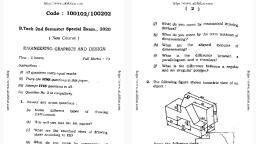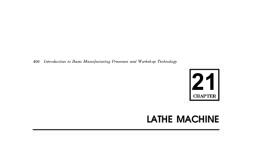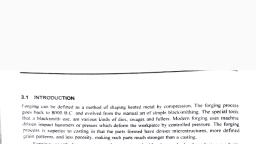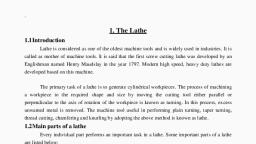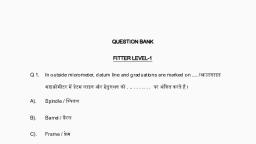Page 1 :
LAB MANUAL, LATHE MACHINE, BY, ER. A KUMAR
Page 2 :
Lathe, Definition, Lathe is a machine, which removes the metal from a piece of work to the required, shape and size., , ➢ Lathe is one of the most important machine tools in the metal working industry. A, , lathe operates on the principle of a rotating workpiece and a fixed cutting tool., , ➢, , The cutting tool is feed into the workpiece, which rotates about its own axis, causing the workpiece to be formed to the desired shape., , ➢, , Lathe machine is also known as “the mother/father of the entire tool family”.
Page 3 :
INVENTOROF CENTRE LATHE, ➢ Henry Maudsley was born on an isolated farm, , near Gigghleswick in North Yorkshire and, educated at University Collage London. He was, an outstandingly student, collecting ten Gold, Medals and graduating with an, M.D. degree in 1857.
Page 4 :
⚫ Function of lathe, , Lathe is to remove excess material in the form of chips, by rotating the work piece against a stationary cutting, tool, ➢ Industrial revolution demanded, ⚫, , More production, , ⚫, , More Precision, , ⚫, , Changes in Manufacturingprocess, , ⚫, , Lead to the Development of High speed, , ⚫, , Special purpose lathes
Page 5 :
MAIN PARTS, Lathe Machine is also known as “Centre Lathe”,, because it has two centres between which the job, can be held and rotated., The main parts of centre lathe are:, ➢ Bed,, ➢ Head stock,, ➢ Tail stock,, ➢ Carriage,etc
Page 6 :
Lathe
Page 7 :
Lathes, ⚫ Lathes are the oldest machine tools, ⚫ Lathe Components, ⚫ Bed: supports all major components, ⚫ Carriage: slides along the ways and consists of the cross-, , slide, tool post, apron, ⚫ Headstock – Holds the jaws for the work piece, supplies, , power to the jaws and has various drive speeds, ⚫ Tailstock – supports the other end of the workpiece, ⚫ Feed Rod and Lead Screw – Feed rod is powered by a set of, , gears from the headstock
Page 8 :
Working principle of lathe
Page 9 :
Workingprinciple of lathe, ⚫ If the tool moves parallel, , to work piece cylindrical, surface is formed
Page 10 :
Working principle of lathe, ⚫ If the tool moves, , inclined to the axis it, produces a taper, , surface and is called, taper turning.
Page 11 :
Working principle oflathe, ⚫ It holds the work between two supports called centers., ⚫ Chuck or Face plate is also used for holding the work., ⚫ Chuck or face plate is mounted on machine spindle, ⚫ Cutting tool is held and supported on a tool post., ⚫ Movement of the job is rotation about spindle axis, ⚫ Tool is fed against the revolving work, ⚫ Movement of the tool is either parallel to or at any inclination to the, , work axis
Page 12 :
Specifications of Lathe, 1), , a) Height of centers, b) type of bed(straight , semi gap, or gap), c) center distance, , 2., , a)swing over bed, b)swing over cross slide, c) swing in gap, d) gap in front of face place, , 3., , a) spindle speeds range, b) spindle nose, , c) spindle bore, d) taper nose
Page 13 :
Specifications of Lathe, a)Metric thread piches, b)lead screw pitch, c)longitudinal feeds, d)cross feeds, 5) a) cross slide travel, b)top slide travel, 4), , 6), 7), 8), , c) tool section, a)tailstock sleeve travel, b)taper in sleeve bore, , Motor horsepower and RPM, shipping dimensions --length*width*height*weight
Page 14 :
TYPES OFLATHES, ➢ Engine Lathe or center lathe, ⚫ It is most common type of lathe and is widely used in workshop., ⚫ The speed of the spindle can be widely varied as desired which is not, , possible in a speed lathe., ➢ Bench Lathe, ⚫ Small lathe which can mounted on the work bench, ⚫ It is used to make small precision and light jobs., ➢ Speed lathe, ⚫ It is named because of the very high speed of the head stock spindle., ⚫ Consists head stock, a tail stock and tool post. it has no gear box., ⚫ Applicable in wood turning, metal spinning and operations.
Page 15 :
TYPES OFLATHES, ➢ Tool room lathe :, , • It is similar to an engine lathe, designed for obtaining accuracy., • It is used for manufacturing precision components, dies, tools, jigs, ➢, ⚫, ⚫, ⚫, ⚫, ⚫, , etc. and hence it is called as tool room lathe., Special purpose lathes :, Gap lathe, Instrument lathe, Facing lathe, Flow turning lathe, Heavy duty lathe
Page 16 :
➢ Automatic Lathe, ⚫ A lathe in which the work piece is automatically fed and removed, , without use of an operator., ⚫, , It requires very less attention after the setup has been made and, the machine loaded., , ➢ Turret Lathe, , ⚫ Turret lathe is the adaptation of the engine lathe where the tail stock, , is replaced by a turret slide(cylindrical or hexagonal)., ⚫, , Tool post of the engine lathe is replaced by a cross slide which can, , hold number of tools., ➢ Capstan lathe, , • These are similar to turrent lathe with the difference that turret is not, fixed but moves on an auxiliary slide. these are used for fast, production of small parts.
Page 17 :
OperatingConditions, , N, , Cutting speed, Workpiece, Depth of cut (d), Machined, surface, , Chuck Feed (f ), Tool, , Chip, Depth of cut
Page 18 :
LATHEOPERATIONS, ➢ Turning: to remove material from the outside diameter of a workpiece to, , obtain a finished surface., ➢ Facing: to produce a flat surface at the end of the workpiece or for making, , face grooves., ➢ Boring: to enlarge a hole or cylindrical cavity made by a previous process, , or to produce circular internalgrooves., ➢ Drilling: to produce a hole on the work piece., ➢ Reaming: to finishing the drilledhole., ➢ Threading: to produce external or internal threads on the workpiece., ➢ Knurling: to produce a regularly shaped roughness on the workpiece.
Page 20 :
Turning.., Cylindrical job, , Cutting, speed, , Workpiece, Depth of cut (d), Machined, surface, , N, , Chuck, , Feed, Tool, , Chip, Depth of cut
Page 21 :
Turning.., ⚫, , Excess Material is removed to reduce, Diameter, , ⚫ Cutting Tool: Turning Tool, ⚫ Work is held in either chuck or between, , centers., ⚫ Longitudinal feed is given to the tool either by, , hand or power.
Page 22 :
Facing, Flat Surface/Reduce length, , Chuck, , Workpiece, , d, Machined, Face, Cutting, speed, , Depth of, cut, Tool, , Feed
Page 23 :
Facing .., ⚫ machine end of job Flat surface, , or to Reduce Length of, , Job, ⚫ Turning Tool, ⚫ Feed: in direction perpendicular to workpiece axis, , ⚫ Length of Tool Travel = radius of workpiece, ⚫ Depth of Cut: in direction parallel to workpiece axis
Page 24 :
Knurling, ⚫ Produce, , rough textured surface, , ⚫ For Decorative and/or Functional Purpose, , ⚫ Knurling Tool, ❑, , A Forming Process, , ❑ MRR~0
Page 25 :
Knurling, Knurled surface, Cutting, speed, Feed, Knurling tool, Tool post, , M ovement, for depth
Page 26 :
Grooving, ⦁ Produces a Groove on workpiece, ⦁ Shape of tool shape of groove, ⦁ Carried out using Grooving Tool A form tool, ⦁ Also called Form Turning
Page 27 :
Grooving.., Shape produced, by form tool, , Form tool, , Feed or, depth of cut, , Groove, , Grooving, tool
Page 28 :
Parting, ⚫ Cutting, , workpiece into Two, ⚫ Similar to grooving, ⚫ Parting Tool, ⚫ Tool rides over – at slow feed, ⚫ Coolant use
Page 29 :
Parting.., , Parting tool, , Feed
Page 31 :
Chamfering, , , , , , , Beveling sharp machined edges, Similar to form turning, Chamfering tool – 45°, To, Avoid Sharp Edges, ⚫, Make Assembly Easier, ⚫, Improve Aesthetics, ⚫
Page 32 :
Drilling, Drill – cutting tool – held in TS – feed from TS, , Quill, clamp moving, Drill, quill, Tail stock, Feed, Tail stock clamp
Page 34 :
Taper Turning.., , Methods, ⦁ Form Tool, ⦁ Swiveling Compound Rest, ⦁ Taper TurningAttachment, ⦁, , Simultaneous Longitudinal and, Cross Feeds
Page 35 :
Taper Turning .., by form tool, , Workpiece, , Taper, , Form, Straight, tool, cutting edge, , , , Direction, of feed
Page 36 :
Taper Turning ,,, by compound rest, Dog, , Mandrel Tail stock quill, , Tail stock, Face plate, , Tool post &, Tool holder, Cross slide, , Direction of feed, Compound rest, Slide, Compound rest, Hand crank,
Page 38 :
Taper Attachment, I., , A bed bracket and keeps the angle plate from moving to the left or the right., , II. carriage bracket moves angle plate in a dovetail and keeps the angle plate from, moving in or out on the bed bracket., III. Taper to be cut is set by placing the guide bar, which clamps to the angle plate, at an, angle to the ways of the lathe bed., IV. sliding block which rides on a dovetail on the upper surface of the, guide bar is secured during the machining operation to the cross slide bar of the, carriage, with the cross feed screw of the carriage being disconnected., V. carriage is traversed during the feeding operation, the cross slide bar, follows the guide bar, moving at the predetermined angle from the ways of the bed, to cut the taper., VI. It is not necessary to remove the taper attachment when straight, turning is desired.
Page 39 :
Thread cutting attachment, ⚫ On the lathe internal and external threads are cut either, , with the help of a thread tool or with the help of tap and, die respectively., ⚫ There, , should, , be, , a certain, , relation, , between, , job, , revolutions and the revolutions of the lead screw to, , control linear movement of the tool parallel to the job, when the half nut is engaged with the lead screw., ⚫ The tool should be ground to the proper shape or profile, , of the thread to be cut., ⚫, , In modern lathes quick change gear box is provided in, which different ratios of the spindle and lead screw
Page 40 :
Lathe Accessories, ⚫ Divided into two categories, ⚫ Work-holding, -supporting, and –driving devices, ⚫ Lathe centers, chucks, faceplates, ⚫ Mandrels, steady and follower rests, ⚫ Lathe dogs, drive plates, ⚫ Cutting-tool-holdingdevices, ⚫ Straight and offset toolholders, ⚫ Threading toolholders, boringbars, ⚫ Turret-type toolposts
Page 41 :
Work holdingDevices, ⚫, , Various work holding attachments such as three jaw chucks, collets, and centers can be, held in the spindle., , ⚫, , Work is held in the lathe with a number of methods,, , ⚫ Between two centres. The work piece is driven by a device called a dog; this method is, , suitable for parts with high length-to-diameter ratio., ⚫ A 3 jaw self-centering chuck is used for most operations on cylindrical work-parts. For, , parts with high length-to-diameter ratio the part is supported by center on the other end., ⚫ Collet consists of tubular bushing with longitudinal slits. Collets are used to grasp and, , hold bar stock. A collet of exact diameter is required to match any bar stockdiameter., ⚫ A face plate is a device used to grasp parts with irregular shapes.
Page 42 :
Mandrels, , Fig : Various types of mandrels to hold work pieces for turning. These mandrels are, usually mounted between centers on a lathe. Note that in (a) both the cylindrical, and the end faces of the workpiece can be machined, whereas in (b) and (c) only, thecylindrical surfacescanbemachined.
Page 43 :
Lathe Centers, ⚫ Work to be, , turned between centers must have, , center hole drilled in each end, ⚫ Provides bearing surface, , ⚫ Support, , during cutting, ⚫ Most common have, solid Morse taper shank, 60º centers, steel with carbide tips, ⚫ Care, , to adjust and lubricate occasionally
Page 44 :
Chucks, ⚫ Used, , extensively for holding work for machining, , operations, ⚫ Work large or unusual shape, , ⚫ Most, , commonly used lathe chucks, , ⚫ Three-jaw universal, ⚫ Four-jaw independent, ⚫ Collet chuck
Page 45 :
Three-jaw UniversalChuck, ⚫ Holds round and hexagonal work, ⚫ Grasps work quickly and accurate within few, , thousandths/inch, ⚫ Three jaws move simultaneously when adjusted by, , chuck wrench, ⚫ Caused by scroll plate into which all three jaws fit, , ⚫ Usually has three jaws which move in unison as an, , adjusting pinion is rotated., ⚫ The advantage of the universal scroll chuck is its ease, of operation in centering work for concentric turning., ⚫ This chuck is not as accurate as the independent
Page 46 :
Four Jaw IndependentChuck, ⚫ Used, , to hold round, square, hexagonal, and, irregularly shaped workpieces, ⚫ Has four jaws, ⚫ Each can be adjusted independently by chuck, , wrench, ⚫ Jaws, , can be reversed to hold work by inside, diameter
Page 47 :
TYPES OFCHUCK, Threejaw, chuck, - Forholding cylindrical, stock centered., - For facing/center, drilling,etc., Four-Jaw, Chuck, - This is independent, chuck generally has four, jaws , which are adjusted, individuallyon thechuck, faceby means of, adjusting screws
Page 48 :
Collet Chuck, , ⚫, , Thin jobs can be held by means of, magnetic chucks., , Collet chuck is, used to hold small, workpieces, , Magnetic Chuck, Thin jobs can be, held by means of, magnetic chucks.
Page 49 :
Work holding Devices, Chucks, usually equipped with, 3 or 4 jaws, 3 jaw chucks generally, are self centering., Used for round, work pieces., Can be centered within, .025mm, independently., 4 jaw chucks are for, square, rectangular,, or odd-shaped work, pieces, ⚫ Can be, power, actuated, , (a) and (b) Schematic illustrations of a draw-in-type collets. The workpiece is, placed in the collet hole, and the conical surfaces of the collet are forcedinward by, pulling it with a draw bar into the sleeve. (c) A push-out type collet. (d), Workholding of a part on a face plate.
Page 50 :
Headstock Spindles, Universal and independent chuck fitted to three, types of headstock spindles, 1. Threaded spindle nose, ⚫, , 2., , Screws on in a, clockwise direction, , Tapered spindle nose, ⚫, , Held by lock nut, that tightens on chuck, , 46-50
Page 51 :
Headstock Spindles, Cam-lock spindle nose, , 3., •, •, , Held by tightening cam-locks using T-wrench, Chuck aligned by taper, on spindle nose, , Registration lines on spindle nose, Registration lines on cam-lock, Cam-locks, Cam-lock mating stud on, chuck or faceplate, 46-51
Page 52 :
Collet Chuck, ⚫ Most, , accurate chuck, ⚫ Used for high-precision work, ⚫ Spring collets available to hold round, square, or, hexagon-shaped work pieces, ⚫ Each collet has range of only few thousandths of, an inch over or under size stamped on collet
Page 53 :
Collet Chuck, , |, , Special adapter fitted into taper of headstock spindle, and hollow draw bar, having internal thread inserted in opposite end of headstock spindle. It draws, collet into tapered adapter causing collet to tighten on workpiece.
Page 54 :
Types of LatheDogs, ⚫ Standard, , bent-tail lathe dog, , ⚫ Most commonly used for round, , workpieces, ⚫ Available with square-head setscrews, , of headless setscrews, • Straight-tail lathe dog, – Driven by stud in drive plate, , – Used in precision turning, 46-54
Page 55 :
Types of LatheDogs, ⚫ Safety, , clamp lathe dog, , ⚫ Used to hold variety of work, ⚫ Wide range of adjustment, , • Clamp lathe dog, – Wider range, than others, – Used on all, shapes
Page 56 :
Left-Hand Offset Toolholder, ⚫ Offset to the, , right, ⚫ Designed for machining work close to chuck or, faceplate and cutting right to left, ⚫ Designated by letter L
Page 57 :
Right-Hand Offset Toolholder, ⚫ Offset to the, , left, ⚫ Designed for machining work close to the tailstock, and cutting left to right, ⚫ Also for facing operations, , ⚫ Designated, , by letter R
Page 58 :
Straight Toolholder, ⚫ General-purpose, , type, ⚫ Used for taking cuts in either direction and for, general machining operations, ⚫ Designated by letter S
Page 59 :
Straight Tool holder, ⚫ General-purpose, , type, ⚫ Used for taking cuts in either direction and for, general machining operations, ⚫ Designated by letter S
Page 60 :
Semi automaticlathes, ⚫ Semi automatic lathes are production lathes with human involvement for, , certain operations, ⚫ Semi automatic lathes are production lathes with human involvement for, , certain operations, ⚫ Capstan and turret lathes with additional attachments become semi, , automatic lathes, ⚫ Also called retrofitting, ⚫ Vide range of jobs can be accommodated, ⚫ Higher productionrates
Page 61 :
Semi AutomaticLathes, ⚫ Designed for short continuousruns, , ⚫ Turret or ram in place of tailstock, ⚫ Indexable square tool post on cross slide, , ⚫ Suitable for Drilling, countersinking, reaming, tapping like operations, , ⚫ Turret and Capstan lathes are examples, ⚫ In Turret lathe Turret moves along with saddle, ⚫ In Capstan lathe turret slides over the ram
Page 62 :
TurretLathe, Capable of performing multiple, cutting operations on the same, workpiece, ⚫, , Turning, , ⚫, , Boring, , ⚫, , Drilling, , ⚫, , Thread cutting, , ⚫, , Facing, , Turret lathes are very versatile, Types of turret lathes, ⚫, , Ram-type: ram slides in a, separate base on the saddle, , ⚫, , Saddle type:, ⚫, , more heavily, constructed, , ⚫, , Used to machine large, workpeiceces
Page 65 :
TurretLathe, ➢ These machines are capable of, , carrying out multiple cutting, operations on the same, workpiece., ➢ Several cutting tools are, , mounted on a tetra, penta, or, hexagonal turret, which, replaces the tailstock., ➢ These tools can be rapidly, , brought into action, against the workpiece one by, one by indexing the turret.
Page 66 :
Comparision of turret & engine lathe, Turret lathe, ⚫ Turret lathes are relatively more, , robust and heavy duty machines, .work on chucking type jobs held in, the quick acting chucks, ⚫ The heavy turret being mounted on, , the saddle which directly slides with, larger stroke length on the main, bed, ⚫, , ⚫, , One additional guide rod or pilot bar, is provided on the headstock of the, turret lathes to ensure rigid axial, travel of the turret head, whereas in turret lathes external, threads are generally cut, if, required, by a single point or, multipoint chasing tool being, mounted on the front slide and, moved by a short leadscrew and a, , Capstan lathe, ⚫ Capstan lathes generally deal, , with short or long rod type blanks, held in collet,, ⚫ In capstan lathe, the turret travels, , with limited stroke length within a, saddle type guide block, called, auxiliary bed, which is clamped, on the main bed, ⚫ External screw threads are cut in, , capstan lathe, if required, using a, self opening die being mounted in, one face of the turret,
Page 67 :
AUTOMATIC LATHES
Page 68 :
AUTOMATIC LATHES, ⚫, , Machine tools in which components are machined automatically., , ⚫ The working cycle is fully automatic that is repeated to produce duplicate parts with, , out participation of operator., ⚫ All movements of cutting tools, their sequence of operations, applications, feeding of, , raw material, parting off, un loading of finished parts all are done on machine., ⚫ All working & idle operations are performed in definite sequence by control system, , adopted in automatic which is set up to suit a given work., ⚫ Only operation reqd to be performed manually is loading of bar stock/ individual, , casting/ forged blanks., ⚫ These machines are used when production requirements are too high for turret lathes, , to produce economically.
Page 69 :
Automatic Lathes, ⚫ Manual machine controls replaced by various mechanisms, ⚫ Parts are fed and removed automatically, ⚫ May have single or multiple spindles, ⚫ Automatic lathes uses servo motor, ⚫ Automatic lathes Limited ranges of variety and sizes
Page 70 :
Automatic LatheFeatures, ⚫ Minimum man power utilized, ⚫ Meant for mass production, ⚫ Manual machine controls replaced by various mechanisms, ⚫ To eliminate the amount of skilled labour., , ⚫ Mechanisms enable to follow certain prescribed frequency, ⚫ Parts are fed and removed automatically, , ⚫ Minimizing the loading and unloadingtime, ⚫ May have single or multiple spindles, ⚫ Tool set up may be permanent, ⚫ May have horizontal or vertical spindles, ⚫ More accuracy can be obtained
Page 71 :
Advantages, ⚫ Greater production over a given period., ⚫ More economy in floor space., ⚫ Improvement in accuracy., ⚫ Floor space maintenance and inventory requirements are reduced., ⚫ More consistently accurate work than turrets., ⚫ More constant flow of production., ⚫ Scrap loss is reduced by reducing operator error., ⚫ During machine operation operator is free to operate another machine/ can, , inspect completed parts.
Page 72 :
CLASSIFICATIONOF AUTOMATICLATHES, ⚫ Depending up on type of work machined these machines are classified as:, , 1., , Magazine loadedAutomatics:, , ⚫, , Machines used for producing components from separate blanks., , ⚫, , Also called as automatic checking machines., , 2., , Automatic Bar Machines:, , ⚫, , ⚫, , designed for machining components from bar/ pipe stock., M/c’s are used for manufacture of high quality fasteners (screws, nuts),, bushings, shafts, rings, rollers, handles which are usually made of bar / pipe, stock.
Page 73 :
⚫ Depending upon number of work spindles, automatic lathes are classified as:, 1., , Single SpindleAutomatics., , 2., , Multi SpindleAutomatics., , ⚫, , Depending upon purpose & arrangement of spindle also automaticsare, classified as:, , 1., , Purpose➔ General & single purpose m/c., , 2., , Arrangement of spindle➔ Horizontal & vertical
Page 74 :
I), , Type of Single SpindleAutomatics:, , a) Automatic Cutting Off Machine:
Page 75 :
⚫These, , machines produce short w/p’s of simple form by means of cross sliding, , tools. Machines are simple in design., ⚫Head, ⚫2, , stock with spindle is mounted on bed., , cross slides are located on bed at front end of spindle., , ⚫CAMS, , on cam shaft actuate movements of cross slide through system of levers., , Operation:, ⚫, , The reqd length of work(stock) is fed out with a cam mechanism, up to stock, stop which is automatically advanced in line with spindle axis at each end of, , cycle., ⚫, , Stock is held in collet chuck of rotating spindle., , ⚫, , Machining is done by tolls that are held in slides operating only in cross wise, direction., , ⚫, , Typical simple parts (3 to 20 mm dia) machined on such a machine is shown in, fig.
Page 76 :
b) Single spindle Automatic Screwm/c:
Page 77 :
⚫ Used for producing small screws(12.7 to 60 mm dia) generally, but also in, , production of all sorts of small turned parts., ⚫ These are completely automatic bar type turret lathes, designed for machining, , complex internal & external surfaces on parts made of bar stock/separateblanks., ⚫ Up to 10 different cuttingtools can be employed at one time in tooling of this kind, , of screw machine., ⚫ 2 cross slides(front & rear) are employed for cross feedingtools., ⚫ Vertical tool slides for parting off operation may also be provided ., ⚫ Head stock is stationary & houses the spindle., ⚫ Bar stock is held in collet chuck & advanced after each piece is finished & cutoff., ⚫ All movements of machine units are actuated by cams mounted on cam shaft.
Page 78 :
⚫ Bar stock is pushed through stock tube in a bracket & its leading endis, , clamped in rotatingspindle by means of collet chuck., ⚫ By stock feeding mechanism bar is fed out for next part., ⚫ Machining of central hole is done by tools that are mounted on turretslide., ⚫ Parting off/ Cutting off, form tools are mounted on cross slide., ⚫ At end of each cut turret slide is with drawn automatically & indexed to, , bring next tool to position.
Page 79 :
c) Swiss type automatic screw/Sliding headscrew:
Page 81 :
⚫ As name implies in this m/c head stock is movable & tools are fixed., ⚫ These machines are used for machining long accurate parts of small diameter.(2to, , 25mm)., ⚫ Bar stock is held in rotating collet in head stock & all longitudinal feedsare, , obtained by cam which moves entire head stock as unit., ⚫ Rotating bar stock is fed through hard bushing in centre of tool head., ⚫ Tool head consists of 5 single point tools is placed radially around bushing., ⚫ Mostly diameter turning is done by 2 horizontal slides, other 3 slides used for, , operations such as knurling, chamfering, cutoff., ⚫ Tools are controlled & positioned by cams that bring tool in as needed toturn,, , face, form, cutoff w/p from bar as it emerges from bushing. Close tolerances, 0.005 to 0.00125 mm are obtained.
Page 82 :
II) MultiSpindleAutomatics:, ⚫ These are fastest type of production machines and are made in a variety of, , models with 2,4,5,6,8 spindles., ⚫ In contrast with single spindle m/c where one turret face at a time is, , working on one spindle, in multi spindle m/c all turret faces works on all, , spindles at same time., ⚫ Production capacity is higher, machining accuracy is lower compared to, , single spindle., ⚫ Because of longer set up time, increased tooling cost this machines are, , less economical than other on short runs, more economical for longer, runs.
Page 83 :
a)Parallel Action Automatics/ Multiple Flow m/c:
Page 84 :
⚫ In this type of machine same operation is performed on each spindle, w/p is, , finished in each spindle in one working cycle., ⚫ It means that No. of components being machined== No. of spindles inmachine., ⚫ Rate of production is high & machine can be used to machine simple partsonly, , since all the machining processes are done at one position., ⚫ These machines are usually automatic cuttingoff bar type machines, used to, , perform same work as single spindle automatic cut off machines., ⚫ Machine consists of frame with head stock at right end., , ⚫ Horizontal work spindles that are arranged one above the another are housedin, , this head stock., ⚫ Cross slides are located at right & left hand sides of spindles & carry cross, , feeding tools. All working & auxiliary motions of machine unit are obtainedfrom, CAM mounted on cam shaft.
Page 85 :
b) Six Spindle Progressive Action MultiSpindle:
Page 86 :
⚫ In this design of machine, the w/p is machined in states & progressively in station, , after station., ⚫ Head stock is mounted on left end of base of machine., ⚫ It carries spindle carrier which rotates about a horizontal axis through centreof, , machine., ⚫ Workingspindles are mounted on this spindle carriers., ⚫ Spindles carry collets & bars from which w/p’s are machined., ⚫ Bar stock is fed through each spindle from rear side., ⚫ On face of spindle carrier support are mounted cross slides which carry toolsfor, , operations such as cutoff, turning, facing, forming, chamfering.
Page 87 :
⚫ No. of slides === No. of spindles., ⚫ Main tool slide (end tool slide) extends from middle of thissupport., ⚫ Fed of each tool, both cross slide & end tool slides is controlled by itsown, , individual cams., ⚫ In this diagram spindle carrier indexes on its own axis by 60° at each cuttingtool, , retraction., ⚫ As spindle carrier indexes, it carries work from one station to anotherstation, , where different tolls operate on work., ⚫ Stock moves round the circle in counter clock wise direction & returns to station, , no. 6 for cuttingoff.
Page 88 :
Tool layout
Page 89 :
Toollayout, , schematically showing the type and configuration of A, typical tool layout for a particular job being machined in a, single spindle automatic lathe is schematically shown in Fig.
Page 90 :
Tool layout and camdesign, ➢ Pre determined plan for order and method off machining, operations necessary to produce it . Following steps are, recommended for lay out for an automatic lathe.
Page 91 :
Machining Calculations:, Turning, ⚫ Spindle Speed - N, ⚫ v = cutting speed, ⚫ Do = outer diameter, , ⚫ Feed Rate - fr, , in/min), , (rpm), , v, N=, π Do, fr = N, , (mm/min -or-, , f, , ⚫ f = feed per rev, , ⚫ Depth of Cut - d, , in/rev), , Do − D f, d=, 2, , ⚫ Do = outer diameter, , L, Tm =, fr, , ⚫ Df = final diameter, , ⚫ Machining Time - Tm, ⚫ L = length of cut, , (mm/rev -or-, , MRR= v f, , ⚫ Mat’l Removal Rate - MRR, , (min), d, , (mm3/min -or- in3/min)
Page 92 :
Thank You !!!





